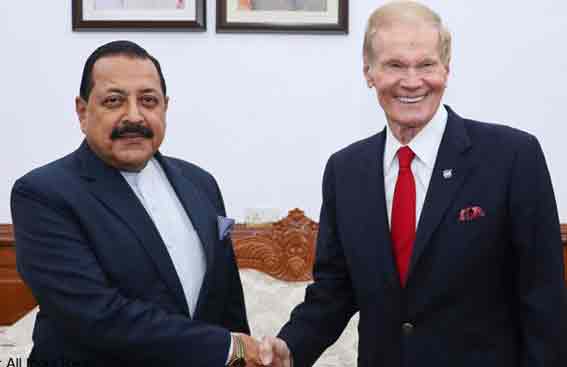India-US Joint Launch of Remote Sensing Satellite to Elevate Earth Observation Capabilities

The India-US space collaboration, marked by joint satellite launches, human spaceflights, and commercial partnerships, signifies a shared commitment to advancing Earth observation and bilateral space exploration efforts.
In a significant development, Union Minister Jitendra Singh revealed that India and the United States will launch a collaborative remote sensing satellite in the year's first quarter. The satellite, designated as the NASA-ISRO Synthetic Aperture Radar (NISAR), is scheduled for deployment using Indis’s Geosynchronous Satellite Launch Vehicle (GSLV). The primary objective of this joint venture is to bolster observation capabilities, with a specific focus on studying diverse facets such as land ecosystems, solid earth deformation, polar cryosphere, sea ice, and coastal oceans.
NASA is actively exploring opportunities for private astronaut missions involving Indian astronauts, with a tentative schedule for 2024. The collaboration has given rise to a Joint Working Group (JWG) on human spacecraft cooperation. The meeting of the India-USA JWG on Civil Space Cooperation (CSJWG) underscored the commitment to enhancing bilateral space cooperation.
ISRO, in collaboration with the Department of Space (DoS), is currently in discussions with prominent US companies to explore specific avenues of cooperation. Simultaneously, efforts are underway to foster collaborations with Indian commercial entities. The ongoing discussion between ISRO and NASA has culminated in the development of a concept paper on the Implementing Arrangement (IA), which is currently under consideration. After successive iterations and mutual consensus, the document is in the process of obtaining intra-governmental approvals.
The objective of a joint remote sensing satellite between the two nations is to enhance Earth’s observation capabilities, marking a substantial advancement in bilateral space collaboration. Remote sensing satellites play a crucial role in monitoring and collecting data about the Earth's surface, atmosphere, and oceans. These satellites provide invaluable information for a range of applications, including agriculture, urban planning, natural resource management, and disaster response. By combining their resources, India and the US aim to develop a state-of-the-art satellite system that significantly improves the accuracy and efficiency of remote sensing data collection.
The collaborative satellite project benefits from the technological expertise of both nations. India's space agency, the ISRO, is renowned for its successful space missions and has a proven track record in satellite development. Meanwhile, the United States NASA brings its vast experience in space exploration and cutting-edge technologies to the table. The synergy between the two agencies is expected to result in a satellite that leverages the strengths of both nations, pushing the boundaries of remote sensing capabilities.
The joint satellite is poised to make significant contributions across various domains. In agriculture, for example, the satellite's high-resolution imagery aids farmers in monitoring crop health, optimizing irrigation, and predicting yield. Urban planners use the data for efficient city development and infrastructure management. Environmentalists will benefit from enhanced monitoring of ecosystems, biodiversity, and climate patterns. Additionally, the satellite will be crucial in disaster management by providing real-time information during natural calamities such as hurricanes, wildfires, and floods.
The collaboration between India and the United States in space exploration represents a significant stride toward advancing Earth observation capabilities and fostering bilateral cooperation in space exploration. The joint efforts encompass satellite launches, human spaceflight programs, and collaborations with commercial entities, reflecting a shared commitment to the advancement of space exploration.
